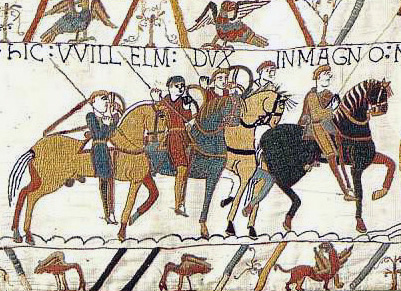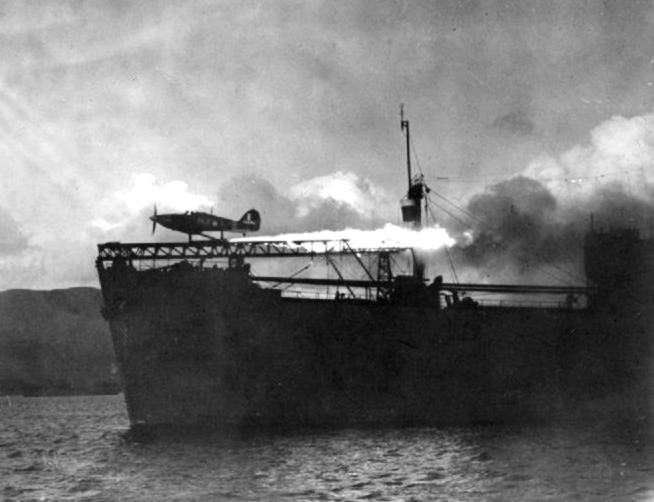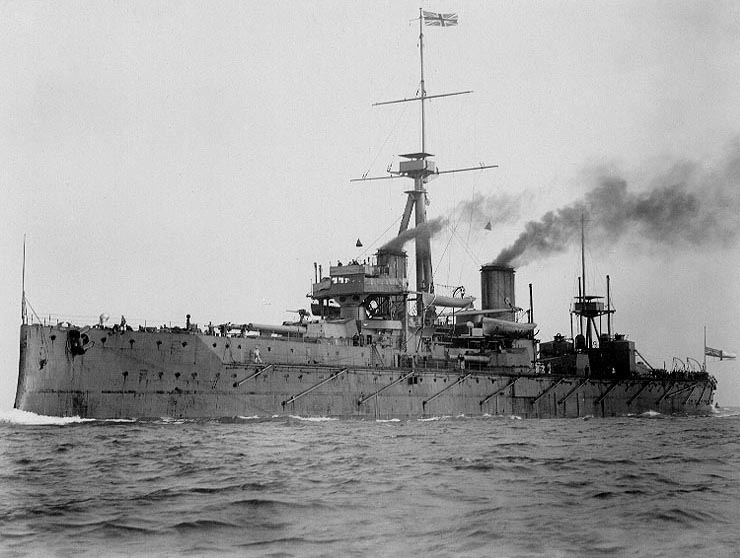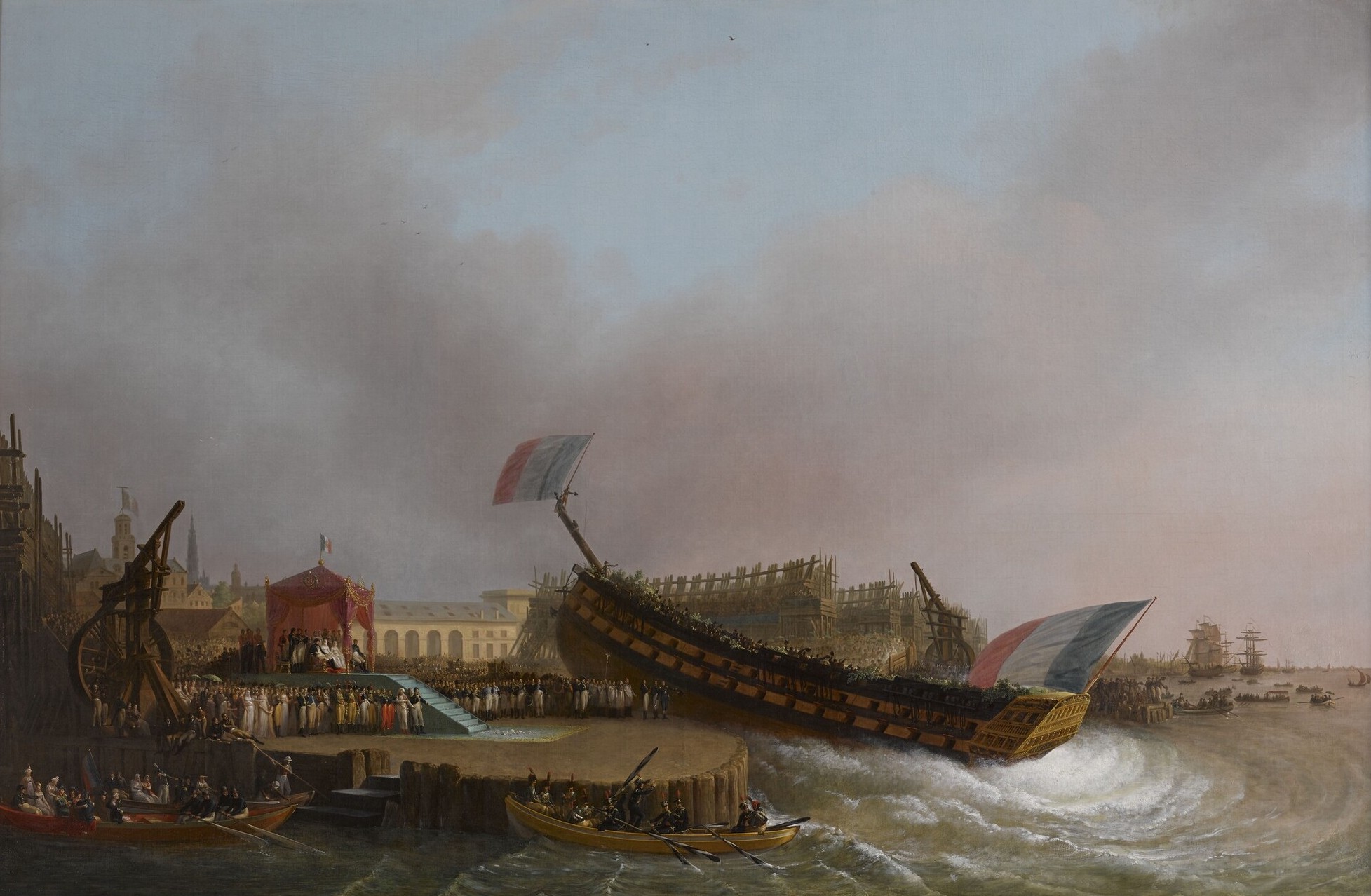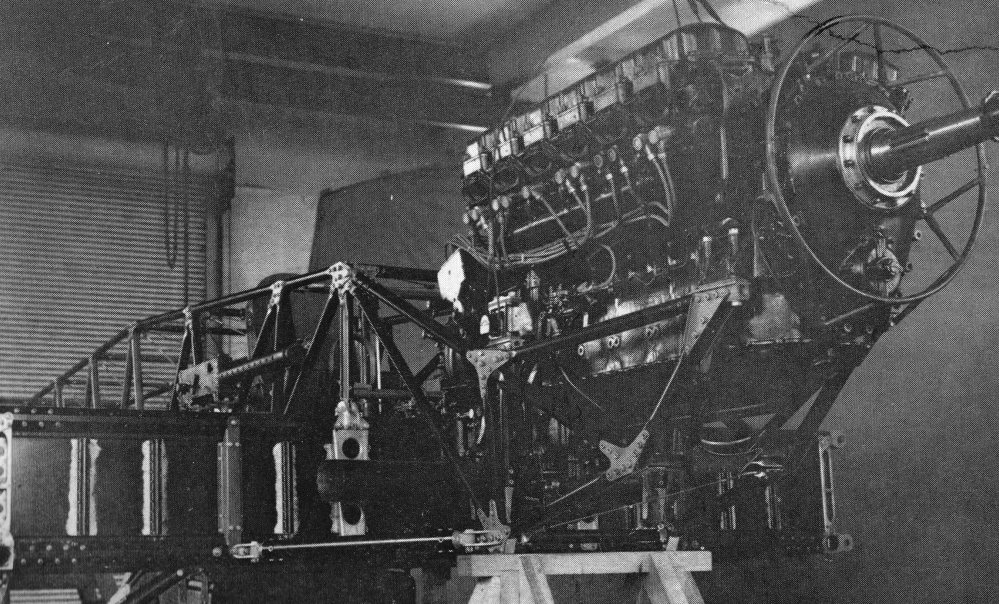|
Michael E
SS ''Michael E'' was a cargo ship that was built in 1941. She was the first British catapult aircraft merchant ship (CAM ship): a merchant ship fitted with a rocket catapult to launch a single Hawker Hurricane fighter aircraft to defend a convoy against long-range German bombers. She was sunk on her maiden voyage by a German submarine. Description ''Michael E'' was built by William Hamilton & Co Ltd, Port Glasgow. Launched in 1941, she was completed in May of that year. She was the United Kingdom's first CAM ship, armed with an aircraft catapult on her bow to launch a Hawker Sea Hurricane. The ship was long between perpendiculars ( overall), with a beam of . She had a depth of and a draught of . She was measured at and . She had six corrugated furnaces feeding two single-ended boilers with a combined heating surface of . The boilers fed a 443 nominal horsepower triple-expansion steam engine that had cylinders of , and diameter by stroke. The engine was buil ... [...More Info...] [...Related Items...] OR: [Wikipedia] [Google] [Baidu] [Amazon] |
United Kingdom
The United Kingdom of Great Britain and Northern Ireland, commonly known as the United Kingdom (UK) or Britain, is a country in Northwestern Europe, off the coast of European mainland, the continental mainland. It comprises England, Scotland, Wales and Northern Ireland. The UK includes the island of Great Britain, the north-eastern part of the island of Ireland, and most of List of islands of the United Kingdom, the smaller islands within the British Isles, covering . Northern Ireland shares Republic of Ireland–United Kingdom border, a land border with the Republic of Ireland; otherwise, the UK is surrounded by the Atlantic Ocean, the North Sea, the English Channel, the Celtic Sea and the Irish Sea. It maintains sovereignty over the British Overseas Territories, which are located across various oceans and seas globally. The UK had an estimated population of over 68.2 million people in 2023. The capital and largest city of both England and the UK is London. The cities o ... [...More Info...] [...Related Items...] OR: [Wikipedia] [Google] [Baidu] [Amazon] |
Aircraft Catapult
An aircraft catapult is a device used to help fixed-wing aircraft gain enough airspeed and lift for takeoff from a limited distance, typically from the deck of a ship. They are usually used on aircraft carrier flight decks as a form of assisted takeoff, but can also be installed on land-based runways, although this is rare. The catapult used on aircraft carriers consists of a track or slot built into the flight deck, below which is a large piston or ''shuttle'' that is attached through the track to the nose gear of the aircraft, or in some cases a wire rope, called a catapult bridle, is attached to the aircraft and the catapult shuttle. Other forms have been used historically, such as mounting a launching cart holding a seaplane on a long girder-built structure mounted on the deck of a warship or merchant ship, but most catapults share a similar sliding track concept. Different means have been used to propel the catapult, such as weight and derrick, gunpowder, flywheel, co ... [...More Info...] [...Related Items...] OR: [Wikipedia] [Google] [Baidu] [Amazon] |
Nicholas Eustathiou Family
Nicholas is a male name, the Anglophone version of an ancient Greek name in use since antiquity, and cognate with the modern Greek , . It originally derived from a combination of two Greek words meaning 'victory' and 'people'. In turn, the name means "victory of the people." The name has been widely used in countries with significant Christian populations, owing in part to the veneration of Saint Nicholas, which became increasingly prominent in Western Europe from the 11th century. Revered as a saint in many Christian denominations, the Eastern Orthodox, Catholic, and Anglican Churches all celebrate Saint Nicholas Day on December 6. In maritime regions throughout Europe, the name and its derivatives have been especially popular, as St Nicholas is considered the protector saint of seafarers. This remains particularly so in Greece, where St Nicholas is the patron saint of the Hellenic Navy. Origins The name derives from the . It is understood to mean 'victory of the people', bei ... [...More Info...] [...Related Items...] OR: [Wikipedia] [Google] [Baidu] [Amazon] |
Shipbroking
Shipbroking is a financial service, which forms part of the global shipping industry. Shipbrokers are specialist intermediaries/negotiators (i.e. brokers) between shipowners and charterers who use ships to transport cargo, or between buyers and sellers of vessels. History In the 19th century, it was the work of ship-brokers to procure goods on freight or a charter for ships outward bound. They also went through the formalities of entering and clearing vessels at the customs-house. They collected the freight on vessels brought into port and took an active hand in the management of all business matters between ship-owners and merchants, whether shippers or consignees, for which they were paid a fee. In major British ports, ship-brokers were also usually insurance-brokers. Modern shipbroking Some brokerage firms have developed into large companies, incorporating departments specialising in shipping's various sectors, ''e.g.'' Dry Cargo Chartering, Tanker Chartering, Container Ch ... [...More Info...] [...Related Items...] OR: [Wikipedia] [Google] [Baidu] [Amazon] |
Draft (hull)
The draft or draught of a ship is a determined depth of the vessel below the waterline, measured vertically to its hull's lowest—its propellers, or keel, or other reference point. Draft varies according to the loaded condition of the ship. A deeper draft means the ship will have greater vertical depth below the waterline. Draft is used in under keel clearance calculations, where the draft is calculated with the available depth of water (from Electronic navigational charts) to ensure the ship can navigate safely, without grounding. Navigators can determine their draught by calculation or by visual observation (of the ship's painted load lines). Related terminology A ship's draft/draught is the "depth of the vessel below the waterline measured vertically to the lowest part of the hull, propellers, or other reference point". That is, the draft or draught is the maximum depth of any part of the vessel, including appendages such as rudders, propellers and drop keels if de ... [...More Info...] [...Related Items...] OR: [Wikipedia] [Google] [Baidu] [Amazon] |
Beam (nautical)
The beam of a ship is its width at its widest point. The maximum beam (BMAX) is the distance between planes passing through the outer sides of the ship, beam of the hull (BH) only includes permanently fixed parts of the hull, and beam at waterline (BWL) is the maximum width where the hull intersects the surface of the water. Generally speaking, the wider the beam of a ship (or boat), the more initial stability it has, at the expense of secondary stability in the event of a capsize, where more energy is required to right the vessel from its inverted position. A ship that heels on her ''beam ends'' has her deck beams nearly vertical. Typical values Typical length-to-beam ratios ( aspect ratios) for small sailboats are from 2:1 (dinghies to trailerable sailboats around ) to 5:1 (racing sailboats over ). Large ships have widely varying beam ratios, some as large as 20:1. Rowing shells designed for flatwater racing may have length to beam ratios as high as 30:1, while a cora ... [...More Info...] [...Related Items...] OR: [Wikipedia] [Google] [Baidu] [Amazon] |
Between Perpendiculars
Length between perpendiculars (often abbreviated as p/p, p.p., pp, LPP, LBP or Length BPP) is the length of a ship along the summer load line from the forward surface of the stem, or main bow perpendicular member, to the after surface of the sternpost, or main stern perpendicular member. When there is no sternpost, the centerline axis of the rudder stock is used as the aft end of the length between perpendiculars. Measuring to the stern post or rudder stock was believed to give a reasonable idea of the ship’s carrying capacity, as it excluded the small, often unusable volume contained in its overhanging ends. On some types of vessels this is, for all practical purposes, a waterline measurement. In a ship with raked stems, naturally that length changes as the draught of the ship changes, therefore it is measured from a defined loaded condition. See also * Length overall Length overall (LOA, o/a, o.a. or oa) is the maximum length of a vessel's hull measured parallel to t ... [...More Info...] [...Related Items...] OR: [Wikipedia] [Google] [Baidu] [Amazon] |
Bow (ship)
The bow () is the forward part of the hull of a ship or boat, the point that is usually most forward when the vessel is underway. The aft end of the boat is the stern. Prow may be used as a synonym for bow or it may mean the forward-most part of the bow above the waterline. Function A ship's bow should be designed to enable the hull to pass efficiently through the water. Bow shapes vary according to the speed of the boat, the seas or waterways being navigated, and the vessel's function. Where sea conditions are likely to promote pitching, it is useful if the bow provides reserve buoyancy; a flared bow (a raked stem with flared topsides) is ideal to reduce the amount of water shipped over the bow. Ideally, the bow should reduce the resistance and should be tall enough to prevent water from regularly washing over the top of it. Large commercial barges on inland waterways rarely meet big waves and may have remarkably little freeboard at the bow, whereas fast military ... [...More Info...] [...Related Items...] OR: [Wikipedia] [Google] [Baidu] [Amazon] |
Ceremonial Ship Launching
Ceremonial ship launching involves the performing of ceremonies associated with the process of transferring a vessel to the water. It is a nautical tradition in many cultures, dating back millennia, to accompany the physical process with ceremonies which have been observed as public celebration and a solemn blessing, usually but not always, in association with the launch itself. Ship launching imposes stresses on the ship not met during normal operation and in addition to the size and weight of the vessel represents a considerable engineering challenge as well as a public spectacle. The process also involves Sailors' superstitions, many traditions intended to invite good luck, such as baptism#Boats and ships, christening by breaking a sacrificial bottle of champagne over the bow (ship), bow as the ship is named aloud and launched. Methods There are three principal methods of conveying a new ship from building site to water, only two of which are called "launching". The ol ... [...More Info...] [...Related Items...] OR: [Wikipedia] [Google] [Baidu] [Amazon] |
Bomber
A bomber is a military combat aircraft that utilizes air-to-ground weaponry to drop bombs, launch aerial torpedo, torpedoes, or deploy air-launched cruise missiles. There are two major classifications of bomber: strategic and tactical. Strategic bombing is done by heavy bombers primarily designed for long-range bombing missions against strategic targets to diminish the enemy's ability to wage war by limiting access to resources through crippling infrastructure, reducing industrial output, or inflicting massive civilian casualties to an extent deemed to force surrender. Tactical bombing is aimed at countering enemy military activity and in supporting offensive operations, and is typically assigned to smaller aircraft operating at shorter ranges, typically near the troops on the ground or against enemy shipping. Bombs were first dropped from an aircraft during the Italo-Turkish War, with the first major deployments coming in the World War I, First World War and World War II, Seco ... [...More Info...] [...Related Items...] OR: [Wikipedia] [Google] [Baidu] [Amazon] |
Convoy
A convoy is a group of vehicles, typically motor vehicles or ships, traveling together for mutual support and protection. Often, a convoy is organized with armed defensive support and can help maintain cohesion within a unit. It may also be used in a non-military sense, for example when driving through remote areas. Naval convoys Age of Sail Naval convoys have been in use for centuries, with examples of merchant ships traveling under naval protection dating to the 12th century. The use of organized naval convoys dates from when ships began to be separated into specialist classes and national navies were established. By the French Revolutionary Wars of the late 18th century, effective naval convoy tactics had been developed to ward off pirates and privateers. Some convoys contained several hundred merchant ships. The most enduring system of convoys were the Spanish treasure fleets, that sailed from the 1520s until 1790. When merchant ships sailed independently, a privateer c ... [...More Info...] [...Related Items...] OR: [Wikipedia] [Google] [Baidu] [Amazon] |
Hawker Hurricane
The Hawker Hurricane is a British single-seat fighter aircraft of the 1930s–40s which was designed and predominantly built by Hawker Aircraft Ltd. for service with the Royal Air Force (RAF). It was overshadowed in the public consciousness by the Supermarine Spitfire during the Battle of Britain in 1940, but the Hurricane inflicted 60% of the losses sustained by the ''Luftwaffe'' in the campaign, and fought in all the major theatres of the Second World War. The Hurricane originated from discussions between RAF officials and aircraft designer Sir Sydney Camm about a proposed monoplane derivative of the Hawker Fury biplane in the early 1930s. Despite an institutional preference for biplanes and lack of interest by the Air Ministry, Hawker refined its monoplane proposal, incorporating several innovations which became critical to wartime fighter aircraft, including retractable landing gear and the more powerful Rolls-Royce Merlin engine. The Air Ministry ordered Hawker's ''Interce ... [...More Info...] [...Related Items...] OR: [Wikipedia] [Google] [Baidu] [Amazon] |
